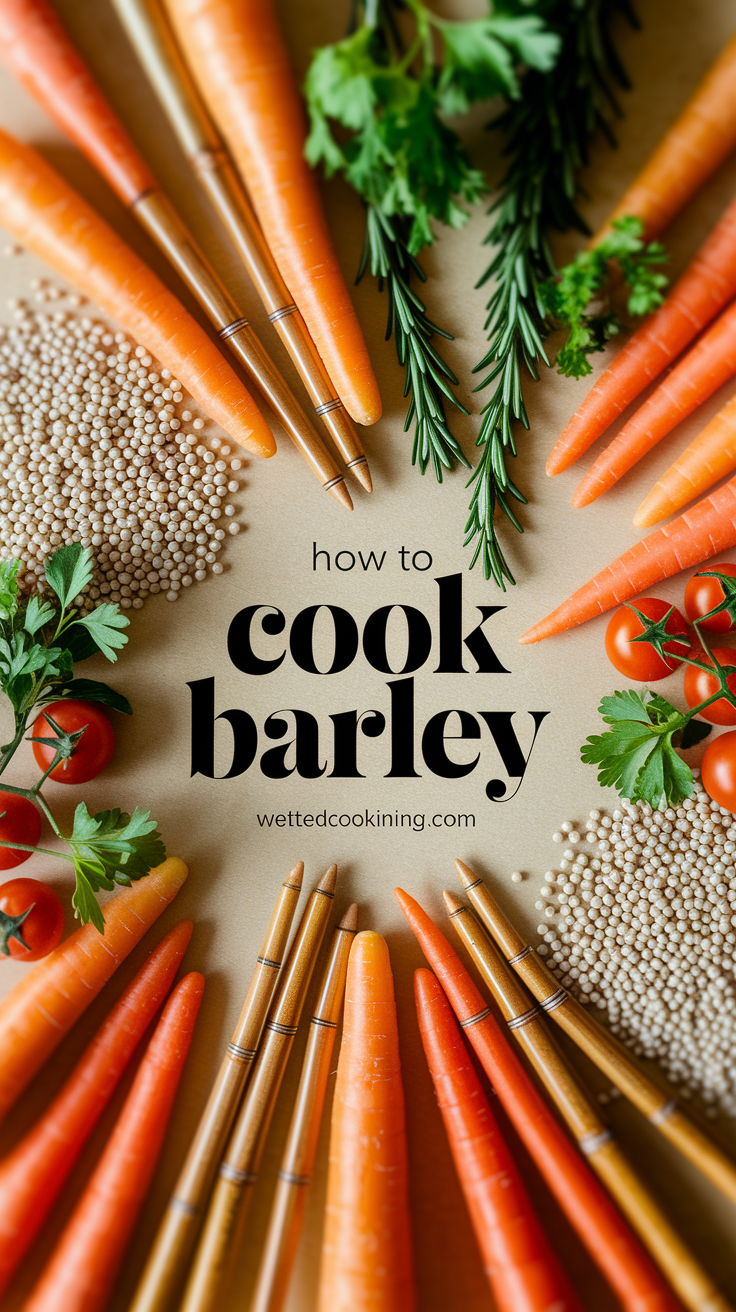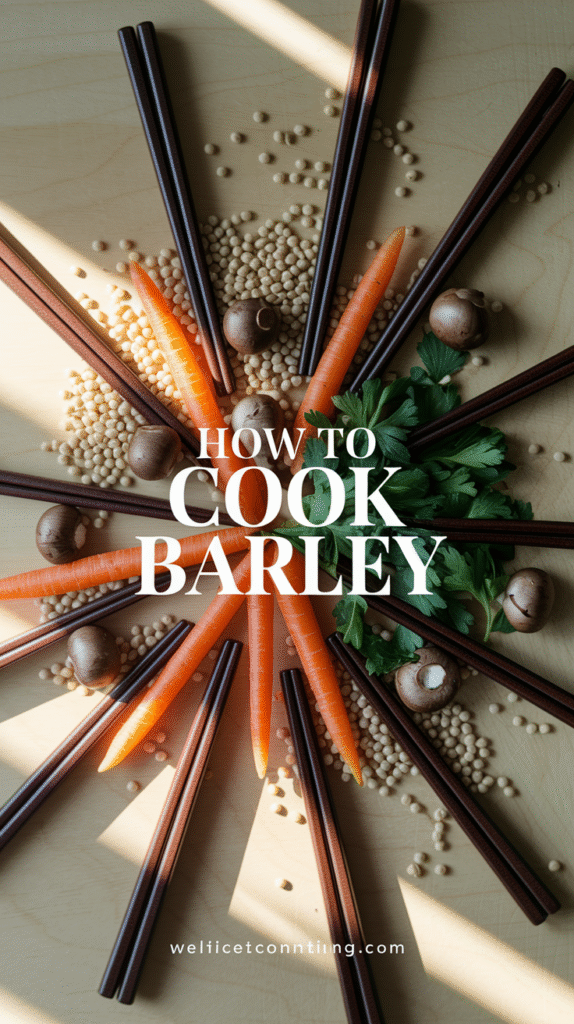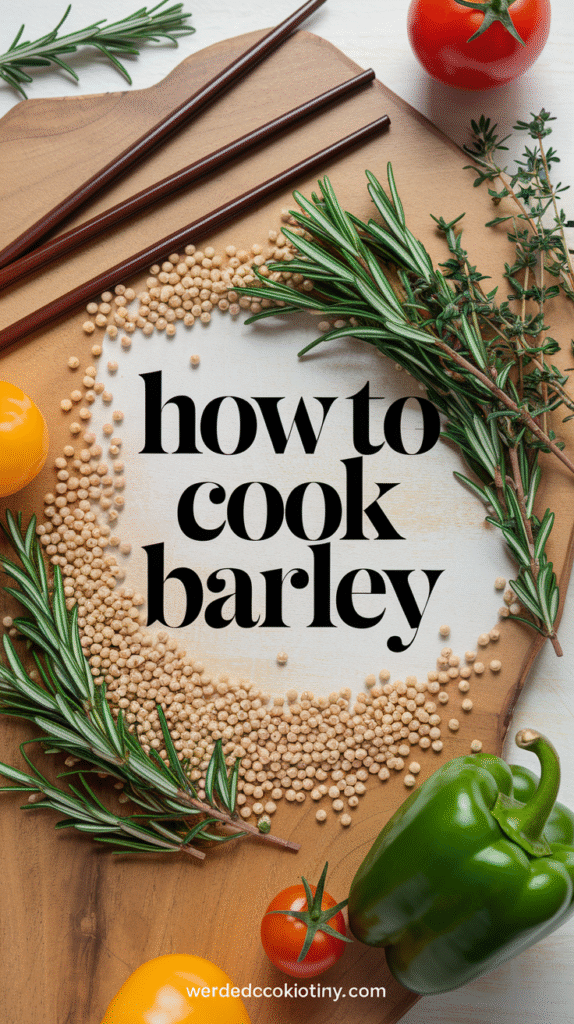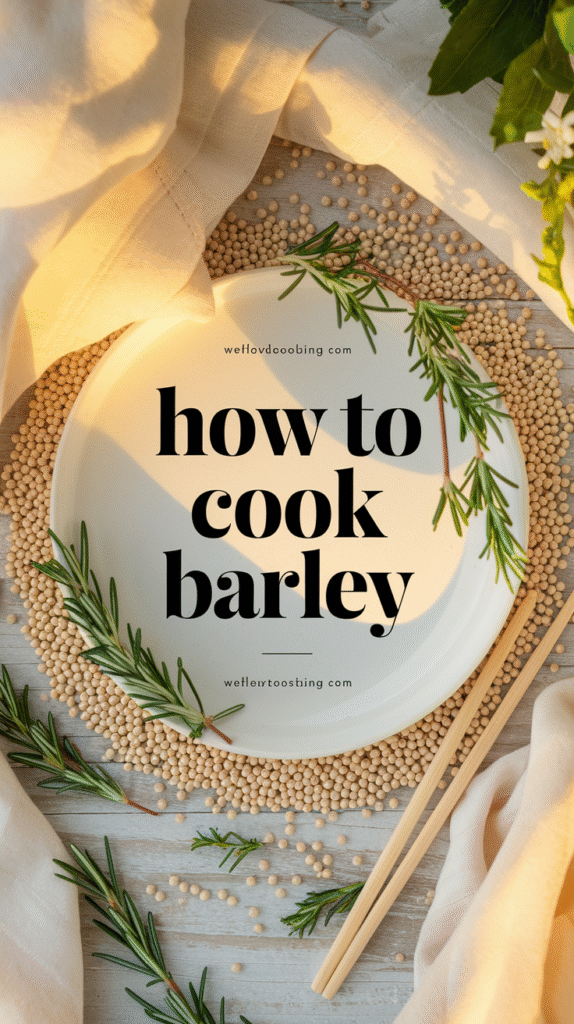Are you looking to master the art of cooking barley? This versatile grain is rich in flavor and texture and can be a great addition to your meals. Whether you want to use it in salads, soups, or as a side dish, knowing how to cook barley properly can make all the difference. Follow these effective techniques to achieve perfect texture every time.
Understanding Barley Types
Before you start cooking, it’s essential to know the different types of barley available:
- Hulled Barley: This type retains its bran layer, making it nutritious but requiring longer cooking time.
- Pearl Barley: This variety has been polished to remove the bran, leading to a quicker cooking time but slightly less nutritional value.
- Barley Flakes: These are flattened grains that cook very quickly, similar to oatmeal.
Preparation Steps
Regardless of the type of barley you choose, rinsing it before cooking is crucial. This step removes any dust or impurities. Here’s how to prepare it:
- Measure the desired amount of barley, usually a cup per serving.
- Rinse under cold water in a fine-mesh sieve until the water runs clear.
- Drain well to remove excess water.
Cooking Techniques
To achieve the perfect texture when cooking barley, consider these methods:
Stovetop Method
- In a pot, combine 1 part barley with 3 parts water or broth for enhanced flavor.
- Bring the mixture to a boil over medium-high heat.
- Reduce the heat to low and cover, letting it simmer. Cooking times vary based on the barley type:
Type of Barley
Cooking Time
Hulled Barley
45-60 minutes
Pearl Barley
25-30 minutes
Barley Flakes
10-15 minutes- Check for doneness; it should be tender but still chewy.
- Once cooked, fluff with a fork and let it sit covered for 5 minutes before serving.
Instant Pot Method
If you’re short on time, using an Instant Pot can expedite the cooking process:
- Add rinsed barley and water or broth in a 1:3 ratio to the pot.
- Seal the lid and set it to high pressure. Cook hulled barley for 40 minutes and pearl barley for 20 minutes.
- Allow a natural release for 10 minutes before quick releasing any remaining pressure.
- Fluff and serve as desired.
Oven Method
For an alternative cooking method, you can also prepare barley in the oven:
- Preheat your oven to 375°F (190°C).
- Combine rinsed barley with water or broth in an oven-safe dish using a 1:3 ratio.
- Cover tightly with foil and bake for about 1 hour.
- Let it sit for 5 minutes before fluffing with a fork.
Flavoring Your Barley
To elevate the taste, consider adding seasonings like salt, herbs, or vegetables during cooking. This enhances the barley’s natural flavor and makes it even more enjoyable. You can also mix in sautéed onions, garlic, or spices according to your dish’s profile.
Serving Suggestions
Cooked barley can be used in various dishes:
- Salads: Toss it with fresh vegetables and a zesty dressing.
- Soups: Use it to add heartiness to hearty soups and stews.
- Side Dishes: Serve it similar to rice or quinoa, paired with proteins or vegetables.
For more detailed cooking tips and recipes, consider visiting Love and Lemons or Whole Foods Market. Both provide comprehensive guides on how to cook barley and its various uses in your kitchen.
Mastering how to cook barley opens up a world of culinary possibilities. With these techniques, you can confidently incorporate this nutritious grain into your meals, enhancing both flavor and texture every time you cook.
Nutritional Benefits of Incorporating Barley into Your Diet
Barley is a versatile grain that is gaining recognition for its numerous health benefits. barley into your diet not only adds a unique flavor but also boosts your overall well-being. Here’s a look at the amazing nutritional benefits of this ancient grain.
Rich in Nutrients
Barley is packed with essential vitamins and minerals that are important for maintaining good health. Here are some key nutrients found in 100 grams of cooked barley:
| Nutrient | Amount |
|---|---|
| Calories | 123 |
| Protein | 2.3g |
| Fat | 0.4g |
| Carbohydrates | 28g |
| Fiber | 3.8g |
| Iron | 0.8mg |
| Magnesium | 18mg |
| Vitamin B6 | 0.1mg |
This array of nutrients contributes to a balanced diet and can support various bodily functions.
High in Fiber
One of the standout features of barley is its high fiber content. Dietary fiber plays a crucial role in digestive health and can help maintain regular bowel movements. Barley contains both soluble and insoluble fiber, which can:
- Enhance feelings of fullness, aiding in weight management.
- Lower cholesterol levels, promoting heart health.
- Stabilize blood sugar levels, beneficial for those with diabetes.
Adding barley to your meals can significantly increase your fiber intake, which is essential for overall health.
Supports Heart Health
The consumption of barley has been linked to better heart health. The soluble fiber in barley helps reduce bad cholesterol (LDL) levels, which is a significant risk factor for heart disease. Additionally, barley is a rich source of antioxidants, which combat oxidative stress and inflammation, further supporting a healthy cardiovascular system.
Balances Blood Sugar Levels
If you are concerned about managing your blood sugar, barley can be a valuable addition to your diet. The unique fibers in barley can slow down carbohydrate absorption, leading to lower blood sugar spikes. Research indicates that replacing refined grains with whole grains like barley can improve insulin sensitivity, a key factor in diabetes management. You can find more information about this benefit on Diabetes.org.
Boosts Digestive Health
Barley into your diet can significantly benefit your digestive system. The high fiber content promotes healthy gut bacteria, which contributes to better digestion and prevents issues such as constipation and irritable bowel syndrome. A healthy gut is crucial for overall health, making barley a smart choice for your meals.
Weight Management
Are you looking to manage your weight more effectively? Barley’s fiber content helps you feel full longer, which can aid in reducing overall calorie intake. By substituting barley for less nutritious grains, you can support weight loss or maintenance goals. Its low glycemic index also means it can provide sustained energy without causing spikes in hunger.
Easy to Incorporate into Meals
Cooking barley is simple, making it easy to add to your favorite recipes. You can:
- Add it to soups or stews for extra texture and nutrition.
- Use barley instead of rice or pasta as a side dish.
- Mix cooked barley into salads for added crunch and fiber.
For cooking instructions and methods, explore HealthyEating.org, where you’ll find a variety of recipes to help you enjoy barley.
Barley is a nutritious grain packed with benefits. From heart health to weight management, its versatility makes it an excellent addition to a balanced diet. Start experimenting with barley today and take advantage of its many advantages!
Creative Recipes Featuring Barley as a Star Ingredient
Barley is an ancient grain that has found its way into modern kitchens, offering a unique flavor and a host of health benefits. Packed with fiber, vitamins, and minerals, barley can be used in a variety of creative recipes. Here are some delightful ways to make barley the star ingredient in your meals.
Barley Risotto
This creamy dish takes a twist on the traditional risotto by using pearl barley instead of Arborio rice. The nutty flavor of barley shines through, making it a heartwarming and comforting option.
- 1 cup pearl barley
- 4 cups vegetable broth
- 1 onion, diced
- 2 cloves garlic, minced
- 1 cup mushrooms, sliced
- 1 cup spinach
- Parmesan cheese (optional)
- Salt and pepper to taste
In a large pot, sauté the onion and garlic until translucent. Add the mushrooms and cook until they’re soft. Stir in the barley, then gradually add the vegetable broth, one cup at a time. Continuously stir until the barley absorbs the liquid and becomes creamy. In the last few minutes of cooking, add the spinach and season with salt and pepper. Top with Parmesan cheese before serving for an extra layer of flavor.
Barley Salad with Roasted Vegetables
This colorful salad is not only nutritious but also visually appealing. Roasted vegetables pair wonderfully with barley, making it a satisfying meal or side dish.
- 1 cup barley
- 2 cups water or broth
- 2 cups mixed vegetables (like bell peppers, zucchini, and eggplant)
- 2 tbsp olive oil
- 1 lemon (juiced)
- Fresh herbs (like parsley or basil)
- Salt and pepper to taste
Begin by cooking the barley in water or broth until tender. Meanwhile, roast your mixed vegetables in a baking dish drizzled with olive oil, seasoning them with salt and pepper. Bake at 400°F (200°C) for 20-25 minutes, or until they’re golden. Once the barley and vegetables are ready, combine them in a large bowl. Drizzle with lemon juice and toss with fresh herbs for a refreshing finish.
Barley Soup with Greens
For a comforting bowl of soup, barley adds texture and heartiness. This soup is perfect for cold days and is easily customizable based on your preferred greens.
- 1 cup barley
- 8 cups vegetable or chicken broth
- 2 carrots, diced
- 1 celery stalk, diced
- 1 onion, chopped
- 2 cups kale or spinach
- Herbs and spices (like thyme or bay leaves)
- Salt and pepper to taste
In a large pot, sauté the onion, carrots, and celery until soft. Add the barley and broth, then bring to a boil. Reduce heat and let simmer for about 30 minutes. Near the end, stir in the greens and your selected herbs. Cook for an additional 5-10 minutes, allowing the flavors to meld. Serve warm for a filling meal.
Barley Pancakes
Start your day with healthy barley pancakes! They’re light, fluffy, and provide a unique twist to your breakfast routine.
- 1 cup barley flour
- 1 tsp baking powder
- ½ tsp salt
- 1 cup milk or non-dairy alternative
- 1 egg
- 2 tbsp melted butter or oil
In a large bowl, combine the barley flour, baking powder, and salt. In another bowl, whisk together the milk, egg, and melted butter. Pour the wet ingredients into the dry, mixing until just combined. Heat a skillet over medium heat and pour batter to form pancakes. Cook until bubbles form, then flip and finish cooking. Serve with your favorite toppings such as berries or maple syrup for a nourishing breakfast.
Barley can shine in countless recipes, offering a range of flavors and nutritional benefits. Discover more creative ideas and tips on how to incorporate this versatile grain into your meals at Barley Seeds.
Whether you’re opting for savory dishes or sweet delights, these recipes showcase how barley can enhance your meals, making them wholesome and delicious.
Comparing Cooking Methods: Stovetop vs. Instant Pot for Barley
Choosing the right cooking method for barley can significantly impact its texture and flavor. Two popular methods are stovetop cooking and using an Instant Pot. Each method has its unique advantages, and understanding these can help you decide which is best for your needs.
Stovetop Cooking
Cooking barley on the stovetop is a traditional method that allows for careful monitoring. Here’s how you do it:
- Rinse the Barley: Always rinse the barley under cold water to remove any dirt or debris.
- Measure the Water: Use a ratio of 3 cups of water for every 1 cup of barley.
- Bring to a Boil: Combine the rinsed barley and water in a pot, and bring it to a boil.
- Simmer: Reduce the heat to low, cover, and let it simmer for about 30-40 minutes. For pearl barley, it may take around 25 minutes.
- Check for Doneness: The barley is done when it’s tender but still chewy. If there’s excess water, drain it off.
Cooking times can vary depending on the type of barley you use. The most common types are:
| Barley Type | Cooking Time |
|---|---|
| Hulled Barley | 45-60 minutes |
| Pearl Barley | 25-30 minutes |
| Quick Barley | 10-15 minutes |
Instant Pot Cooking
The Instant Pot is perfect for those who want a quicker cooking process with less monitoring. Here’s how to cook barley in an Instant Pot:
- Prepare the Barley: Just like with stovetop cooking, begin by rinsing the barley.
- Set the Ratio: Use a 1:1.5 ratio of barley to water (1 cup barley to 1.5 cups water).
- Select the Right Settings: Close the lid, set the valve to sealing, and choose the manual settings. Cook on high pressure for:
- Hulled Barley: 25 minutes
- Pearl Barley: 20 minutes
- Quick Barley: 10 minutes
- Release Pressure: After cooking, either let the pressure release naturally (about 10 minutes) or perform a quick release.
With both methods, you may need to adjust the water depending on your texture preference. The Instant Pot often yields softer barley compared to the stovetop method.
Comparing the Two Methods
When deciding between stovetop and Instant Pot for cooking barley, consider the following:
| Feature | Stovetop | Instant Pot |
|---|---|---|
| Cooking Time | 30-60 minutes | 10-25 minutes |
| Monitoring | Needs close attention | Set and forget |
| Texture | Cooker can control texture | Soft, often slightly mushy |
| Ease of Use | Simple, requires time | Quick, requires setting adjustments |
Ultimately, your choice depends on your schedule, cooking preferences, and desired barley texture. If you enjoy hands-on cooking and the ability to adjust things to your taste as you go, the stovetop might be the best option. On the other hand, if you’re pressed for time and appreciate a “set it and forget it” appliance, then the Instant Pot is for you.
Regardless of your chosen method, cooked barley is a nutritious addition to many meals. For more recipes and tips on cooking with barley, consider visiting Barley Foods.
Experiment with both methods, and enjoy the delicious taste and health benefits that barley can bring to your table.
Common Mistakes to Avoid When Cooking Barley
Cooking barley can be a delicious and nutritious endeavor, but it’s easy to make mistakes that lead to disappointing results. Here, we’ll explore common pitfalls to avoid when preparing this versatile grain.
Choosing the Wrong Type of Barley
Before cooking barley, it’s essential to select the right type for your dish. There are primarily two types of barley—hulless and hulled. Hulless barley is quicker to cook and has a chewier texture, while hulled barley is more nutritious but requires longer cooking. Always check the package description to ensure you’re choosing the right type for your recipe.
Not Rinsing the Barley
One common mistake is neglecting to rinse the barley before cooking. Rinsing helps remove any dust or debris from processing, ensuring a cleaner taste. Simply place the barley in a fine-mesh strainer and rinse it under cold water until the water runs clear.
Improper Water Ratio
Getting the water-to-barley ratio wrong can lead to either soggy or undercooked grains. Typically, the ratio for hulled barley is 3 cups of water for every 1 cup of barley. For pearled barley, you may need less water, about 2.5 cups for 1 cup of grain. Always check the package for specific guidelines.
Cooking at the Wrong Temperature
Cooking barley on too high or too low a heat can result in the grains cooking unevenly. It’s best to bring the water to a boil and then reduce to a simmer. This technique allows the barley to absorb water evenly, leading to a perfect texture.
Ignoring Soaking Time
While not all barley types require soaking, doing so can improve texture and reduce cooking time for hulled barley. If you choose to soak it, aim for about 6-8 hours. Quick-soak by boiling the barley for 2 minutes and letting it sit for an hour if you’re short on time.
Overcooking or Undercooking
Paying attention to cooking time is essential. Overcooked barley can become mushy, while undercooked barley will be hard and chewy. Pearled barley typically cooks in about 35-45 minutes, while hulled barley may take up to 60-90 minutes. Check the grains towards the end of the cooking time for the best results.
Forgetting to Season
Barley on its own can be quite bland, so don’t forget to season it. Adding salt, herbs, and spices during cooking can enhance the flavor significantly. You might even consider cooking barley in broth instead of water for an extra depth of flavor.
Not Using Barley in Varied Dishes
A common oversight is using barley only in soups and stews. While great in these dishes, barley can also be a lovely addition to salads, bowls, and side dishes. Think outside the box—barley can be a delightful base for stir-fries or a filling used in stuffed vegetables.
Neglecting Storage
After cooking, the way you store barley can affect its quality. If you are not consuming all the cooked barley right away, store it in an airtight container in the refrigerator. It’s best to use it within a week to ensure optimal freshness.
Final Thoughts on Cooking Barley
Avoiding these common mistakes will make your barley cooking experience much more enjoyable. Whether you’re making a hearty soup or a refreshing salad, learning how to cook barley properly sets the foundation for delicious and healthy meals.
For more information on cooking barley, consider visiting these resources: Healthline and The Kitchn.
Conclusion
Cooking barley can transform your meals while bringing health benefits to your plate. By mastering effective techniques, you’ll enjoy perfectly cooked grains every time, whether you choose the stovetop or the Instant Pot method. Understanding the nutritional value of barley can motivate you to incorporate it more into your diet, as it offers dietary fiber, vitamins, and minerals that support overall health.
Exploring creative recipes that feature barley as a star ingredient can add delightful variety to your meals. From hearty soups to salads and bowls, barley is incredibly versatile, allowing you to experiment with flavors and ingredients. However, avoiding common mistakes while cooking barley is crucial. From not rinsing the grains to overcooking, these pitfalls can affect the final texture and taste of your dishes.
Ultimately, the goal is to make barley a regular part of your culinary repertoire. Not only will you be indulging in its unique flavor and chewy texture, but you’ll also be boosting the nutritional profile of your meals. As you gain confidence in cooking barley, don’t hesitate to share your favorite recipes and discoveries with friends and family. By doing so, you’ll inspire others to explore this wholesome grain while enriching your own cooking experiences. So, gather your ingredients, choose your cooking method, and enjoy the process of bringing barley into your kitchen.







Leave a Reply